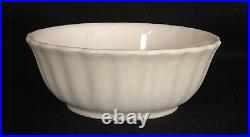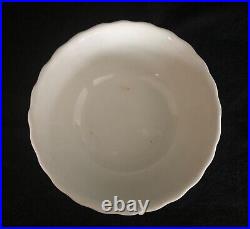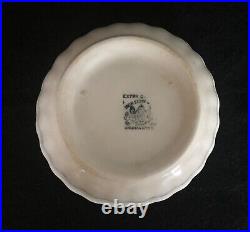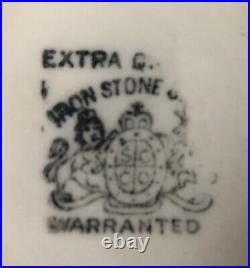This rare antique serving bowl is a beautiful piece that will add a touch of elegance to any occasion, and would be an excellent addition to your collection. Made in America in the late 19th to early 20th century, this ironstone bowl has a fluted pattern and a glossy off-white/cream color. It has a capacity of about 40 fluid ounces to the rim and measures 3 inches in height and 2.75 inches in depth. The top maximum width is about 7 7/8 inches and the bottom is about 4 7/8 inches. This bowl is in excellent condition. Whether it’s for Mother’s Day, Christmas, housewarming, Father’s Day, all occasions, or a birthday, this antique serving bowl is perfect for those who appreciate historic pieces. No chips, no cracks, no obvious crazing. There are manufacture and kiln marks in the bottom of the bowl and on the base. There is some rubbing and discoloration from age and use, as well as some surface scratches on the bottom of the bowl. Photos are part of Item Description. The experts agreed on the age of this bowl as being from the late 19th to early 20th Centuries. The experts consulted agreed that this bowl was made by an American potter. It was common for Victorian-era American potters to copy English design during this era. In the latter part of the 1800s the American manufacturers were producing more and more domestic earthenware and wanted to give an impression of quality to their ware and many used the variations on the British Royal Coat of Arms. And they used a mark identical to the one on this bowl except they had the initials ACCO. The mark on the bottom is similar to the J&G Meakin mark of England, but this is not a Meakin. This bowl is a serving bowl in a shape which was popular in the late 19th and early 20th centuries. The shape was made in several different sizes and by several different American potters. The mark on this bowl is similar to the lion and unicorn mark used by the American China Company of Toronto, Ohio. The initials on this bowl, however, are SCCO and not ACCO as used by American China Co. Even then the last two letters are capital C and capital O in SCCO and capital C raised o in ACCO. When researching a mark, the item’s mark must be identical to that shown in the reference book. One expert unsuccessfully searched through three reference books on marks Debolt’s Dictionary of American Pottery Marks, Lehner’s Encyclopedia if U. Marks, and Kowalsky’s Encyclopedia of Marks. She found that the Sterling China Company of East Liverpool, Ohio, used SCCO in one of its marks, but it was not a Lion and Unicorn mark. The River is South Central Wisconsin’s busiest food pantry. The River also redistributes rescued food and resources to local partners to increase access while minimizing waste. Since 2006, The River has grown to serve over 2,000 people every week in pursuit of its vision: a fully nourished community.






